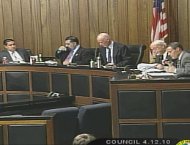Article from: www.thenewspaper.com/news/31/3110.asp
4/14/2010
California City Dumps Red Light Camera After Increasing Yellow
Engineering solutions and an extra second of yellow duration made red light cameras a money loser in San Carlos, California.
 The San Carlos, California City Council voted Monday to cancel its red light camera program after intersection engineering improvements made use of the devices unprofitable. The city had installed a red light camera at Brittan Avenue and Industrial Road on November 27, 2008. As soon as the private contractor Redflex Traffic Systems began mailing out citations there, drivers complained about the shortness of the yellow light. The city checked and found that they were right -- the 3.0 second yellow timing was illegal.
The San Carlos, California City Council voted Monday to cancel its red light camera program after intersection engineering improvements made use of the devices unprofitable. The city had installed a red light camera at Brittan Avenue and Industrial Road on November 27, 2008. As soon as the private contractor Redflex Traffic Systems began mailing out citations there, drivers complained about the shortness of the yellow light. The city checked and found that they were right -- the 3.0 second yellow timing was illegal.
"It was changed to 3.2 seconds and then again through working with the department head of public works, Mr Weil, it was then set at a four-second standard," Police Commander John Reid explained.
The mistake cost the city $156,591 in refunds for the improperly issued tickets. The change to the longer yellow, however, cut into future revenue even more deeply as drivers had sufficient time to clear the intersection without triggering a citation. The police department found, contrary to the claims of the red light camera industry, that the benefits of the timing change did not diminish over time.
"When the camera was initially activated we were averaging approximately ten violations a day," Reid said. "After these adjustments were made to the yellow light duration, it actually reduced the violations down to two violations per day. After continued monitoring of the intersections... we concluded that the violations had been reduced in the area significantly. Back in October we were actually below two and down to 1.5 violations per day... At the end of December we ran statistical data... and found there was another reduction down to 1.3 violations."
With the location now losing $2213 per month, police officials intended to move the camera to a more lucrative location. The intersection of Holly Street and Industrial Road topped the list of possibilities because a prior test had shown the location could generate 61 tickets over a given test period. Additional signal timing changes made to the location from an advanced loop detection system, however, improved traffic flow to such a degree that violations dropped down to zero in a subsequent test. Redflex checked another eleven intersections and failed to find a location that would be profitable. As a result, city leaders lost interest in the program.
"As soon as the time of the amber light was changed to four seconds, violations dropped down to two and continued to drop down from that point," Councilman Mark Grocott said. "As soon as I heard the information about the change in the seconds on the amber light it reduced the need for the camera there at all. So I'm ready to terminate the contract."
The city attorney, however, had signed a three-year deal and could not find a way out of the contract before October 27, 2011. The mayor, angered by the camera program's failure, suggested that San Carlos would threaten to "tell its story" and discourage other mayors from signing on with the Australian camera company if it did not release the city from its contract early.
"The number of accidents which I think truly is much more a measure of safety hasn't changed," Mayor Randy Royce said. "I was disappointed in what Redflex had sold us based on their premise that it would improve safety. It hasn't. It also was not revenue neutral as they told us... I'm not really happy with Redflex... I think in this city they sold us a bill of goods that was misrepresented."
A copy of the police memo on the red light camera program is available in a 110k PDF file at the source link below.
Source: Notification to terminate current contract with Redflex (City of San Carlos, California, 4/12/2010)
Permanent Link for this item
Return to Front Page
 The San Carlos, California City Council voted Monday to cancel its red light camera program after intersection engineering improvements made use of the devices unprofitable. The city had installed a red light camera at Brittan Avenue and Industrial Road on November 27, 2008. As soon as the private contractor Redflex Traffic Systems began mailing out citations there, drivers complained about the shortness of the yellow light. The city checked and found that they were right -- the 3.0 second yellow timing was illegal.
The San Carlos, California City Council voted Monday to cancel its red light camera program after intersection engineering improvements made use of the devices unprofitable. The city had installed a red light camera at Brittan Avenue and Industrial Road on November 27, 2008. As soon as the private contractor Redflex Traffic Systems began mailing out citations there, drivers complained about the shortness of the yellow light. The city checked and found that they were right -- the 3.0 second yellow timing was illegal.